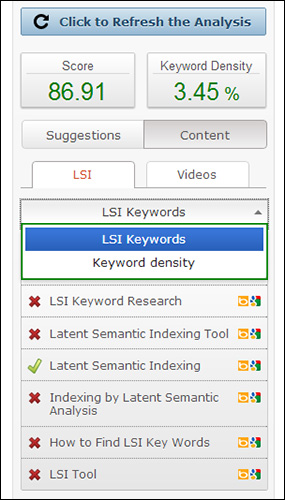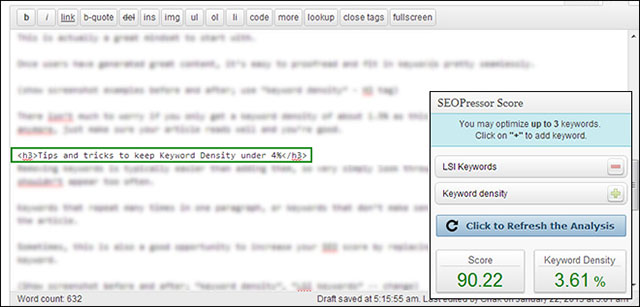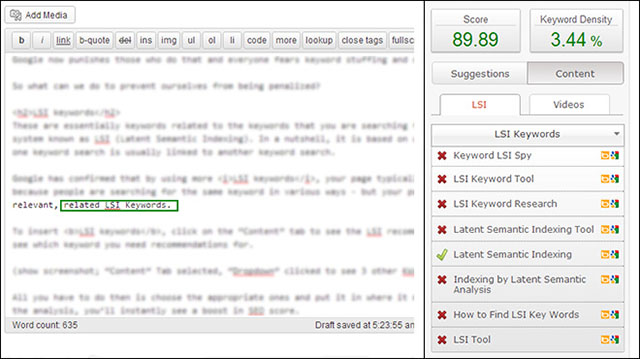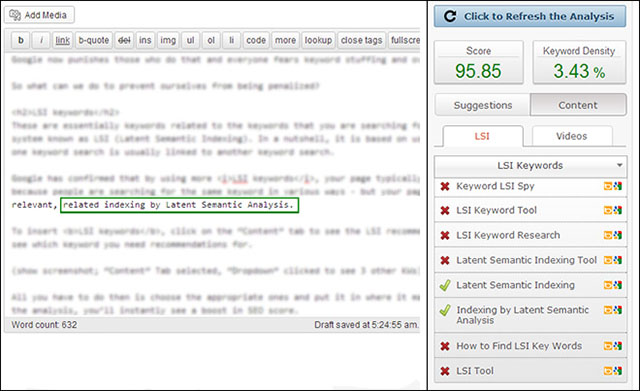(Updated: 30 March 2016 – This is a legacy version of our tutorials. For the latest tutorials of SEOPressor Connect, please visit seopressor.com/tutorials/)
Tutorial Objectives
In the past, keywords would easily rank a webpage just by inserting large amounts of it into one article. However, Google now punishes those who do that and everyone fears keyword stuffing and over-optimizing.
So what can we do to prevent ourselves from being penalized?
These are essentially keywords related to the keywords that you are searching for, and Google does this by using a system known as LSI (Latent Semantic Indexing). In a nutshell, it is based on user search patterns and behavior, how one keyword search is usually linked to another keyword search.
Google has confirmed that by using more LSI keywords, your page typically ranks better, and this makes sense because people are searching for the same keyword in various ways – but your page seems to include all the other relevant, related indexing by Latent Semantic Analysis.
To insert LSI keywords, click on the “Content” tab to see the LSI recommendations and use the drop down menu to see which keyword you need recommendations for.

In this case, we can see that the keywords being used here are “LSI Keywords” and “Keyword density”.
So, all you have to do then is choose the appropriate ones and put it in where it makes the most sense so when you refresh the analysis, you’ll instantly see a green check and a boost in SEO score.


This process should be quite intuitive and just like any keyword, they shouldn’t be randomly stuffed into the article.
Remember that content creation is always first priority in providing value for users; then only do we provide value for search engines.
A safe and recommended number would be 1-2 LSI keywords per SEOPressor keyword.
Keyword density is the percentage of occurrence of your keyword in an article or blog post. In SEO, it is very important to strike an optimal keyword density in an article. If you do not have enough keyword in your article, Google may have difficulty understanding your article’s focus; too much keyword (keyword stuffing) on the other hand put you at risk of over-optimization and getting penalized.
To learn more about how you can achieve the optimal keyword density, visit this blog post here: https://seopressor.com/blog/optimal-keyword-density/
In SEOPressor, the recommended keyword density range is 2-4% (meaning every 100 words, there should only be 2-4 keywords) but once again, always create valuable content for users, then start modifying your article by adding keywords here and there. Even a 2% keyword density is considered extremely beneficial by many SEO gurus.
Some people find it difficult to actually get keywords, solely because they strive to provide users with the best content rather than fervently doing on-page SEO.
This is actually a great mindset to start with.
Once users have generated great content, it’s easy to proofread and fit in keywords pretty seamlessly.


There isn’t much to worry if you only get a keyword density of about 1.5% as this is not Google’s main priority anymore, just make sure your article reads well and you’re good.
Removing keywords is typically easier than adding them, so very simply look through the article and see which keywords shouldn’t appear too often.
Keywords that repeat many times in one paragraph, or keywords that don’t make sense should definitely be taken out of the article.
Sometimes, this is also a good opportunity to increase your SEO score by replacing an unwanted keyword, with an LSI keyword.


If you’ve following the first 6 tutorials up to now accordingly, you should be seeing green checks across the “Suggestions” and “Content” sections of SEOPressor V5 and guess what?
That’s pretty much it! You should have scored around 85 if you followed these tutorials carefully.
But are you done yet?
Basically, yes but for the more advanced users who want to see better results – check out how to use Rich Snippets for better click through rates.
If you are still unsure with what exactly LSI Keyword is, do check out our new LSI Keyword generator tool here: http://lsigraph.com